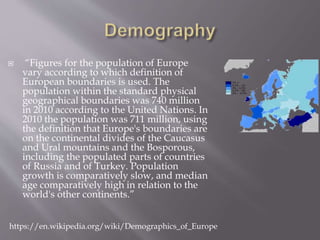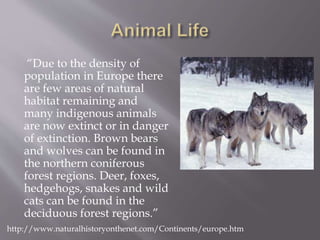Europe
- 1. By: Kang Hee Lee
- 2. “Europe is the second-smallest continent. Only Oceania has less landmass. Europe extends from the island nation of Iceland in the west to the Ural Mountains of Russia in the east. Europes northernmost point is the Svalbard archipelago of Norway, and it reaches as far south as the islands of Greece and Malta.” http://education.nationalgeographic.com/encyclopedia/e urope-physical-geography/
- 3. “Europe can be broadly divided into three regions as shown on the map left. Europe can also be divided according to European Union member states and non-member states as shown on the map right.” “Europe lies entirely in the Northern hemisphere and has four distinct seasons: - Spring - March, April, May - Summer - June, July, August - Autumn - September, October, November - Winter - December, January, February” http://www.naturalhistoryonthenet.com/Continents/europe.ht m
- 4. “For the most part Europe lies in the northern temperate climate zone. Much of far western Europe is classified as a Temperate Oceanic climate, while far southern Europe is a Mediterranean climate in the south. The climate is strongly conditioned by the Gulf Stream, which keeps mild air (for the latitude) over Northwestern Europe in the winter months, especially in Ireland, the UK and coastal Norway. Whilst Western Europe has an oceanic climate, Eastern Europe has a drier, continental climate. Parts of the Central European plains have a hybrid oceanic/continental climate.” https://en.wikipedia.org/wiki/Climate_of_Europe
- 5. “Europe is a unique continent, which is not surrounded by water from all directions, and has an overland border with the neighbouring Asia. Physiographically, it occupies the northwestern part of the large landmass known as Eurasia and surrounded from the north by the Arctic Ocean, from the west by the Atlantic Ocean, from the south by the Mediterranean Sea, and from the southeast by the Black Sea.” https://www.countries-ofthe-world.com/countries-of-europe.html
- 6. “Figures for the population of Europe vary according to which definition of European boundaries is used. The population within the standard physical geographical boundaries was 740 million in 2010 according to the United Nations. In 2010 the population was 711 million, using the definition that Europe's boundaries are on the continental divides of the Caucasus and Ural mountains and the Bosporous, including the populated parts of countries of Russia and of Turkey. Population growth is comparatively slow, and median age comparatively high in relation to the world's other continents.” https://en.wikipedia.org/wiki/Demographics_of_Europe
- 7. “The plant life of Europe is characterised according to climatic region. The deciduous forest region has a wealth of plant life and includes tall and short trees, shrubs, small plant. The coniferous forest region contains trees such as pine, fir and spruce. Due to the cold during the winter months, only short grasses and shrubs can survive in the tundra region. The grassland region is characterised by large open areas of tall or short grass.” http://www.naturalhistoryonthenet.com/Continents/europe.ht m
- 8. “Due to the density of population in Europe there are few areas of natural habitat remaining and many indigenous animals are now extinct or in danger of extinction. Brown bears and wolves can be found in the northern coniferous forest regions. Deer, foxes, hedgehogs, snakes and wild cats can be found in the deciduous forest regions.” http://www.naturalhistoryonthenet.com/Continents/europe.htm







